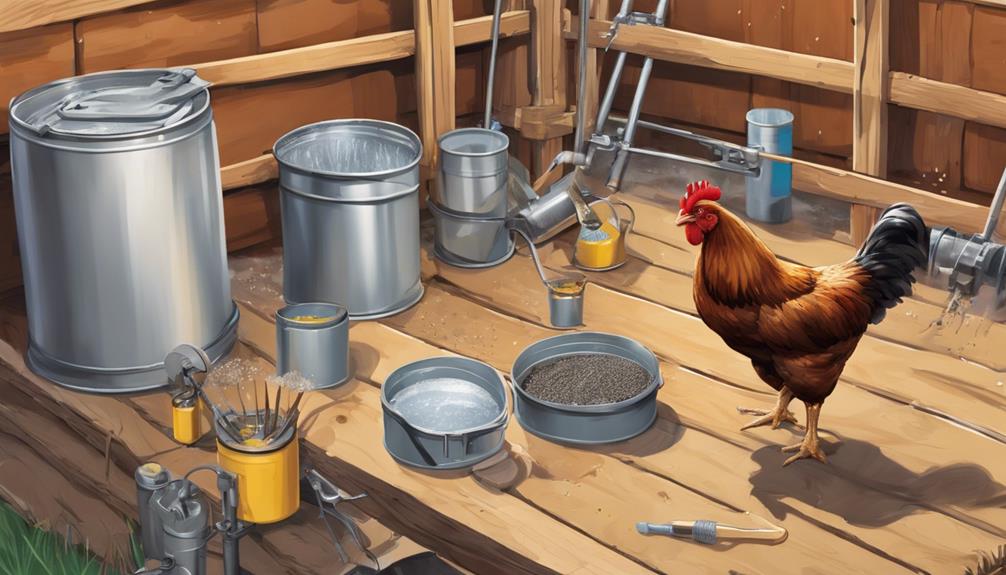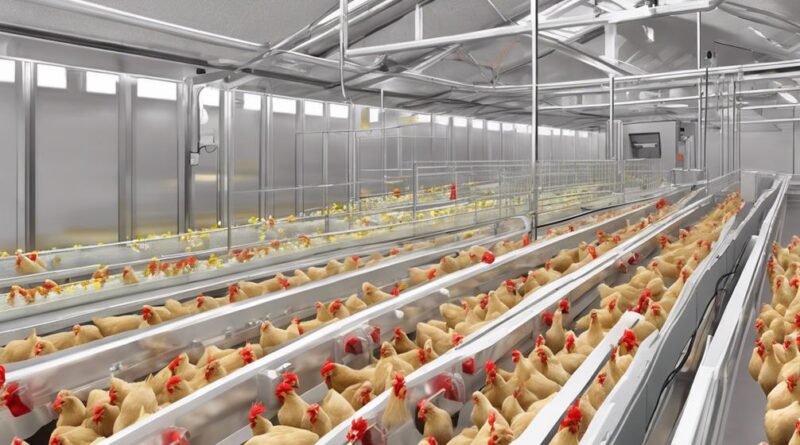Top Tips for Successful Automated Chicken Farming"
To excel in automated chicken farming, focus on selecting the right equipment tailored to your needs, ensuring top-notch ventilation, monitoring feed and water systems meticulously, and conducting regular equipment maintenance. Proper staff training is also crucial for seamless operation. Consider the benefits of automated systems like efficiency and cost-savings. Optimize lighting conditions and invest in data collection for enhanced productivity. Remember, successful automation hinges on these key components for a thriving poultry operation. Mastering these practices sets the foundation for prosperous automated chicken farming. Further insights await to enhance your poultry venture.
Benefits of Automated Systems
Automated systems in chicken farming offer significant advantages in efficiency and productivity. One key benefit is the increased efficiency these systems bring to the farming process. By automating tasks such as feeding, watering, and egg collection, you can streamline operations and reduce the time and effort required to manage your farm. This increased efficiency translates into cost savings and higher output, ultimately boosting your overall productivity.
Moreover, automated systems help decrease the labor needed to run a successful chicken farm. With tasks being automated, you can significantly reduce the amount of manual work required on a day-to-day basis. This not only frees up your time to focus on other aspects of your farm but also reduces the physical strain on you and your employees. By minimizing the need for manual labor, automated systems can make chicken farming a more sustainable and manageable endeavor.
Choosing the Right Equipment
When selecting equipment for your chicken farm, consider the specific needs and requirements of your operation to ensure optimal efficiency and productivity. The right equipment plays a crucial role in the success of your automated chicken farming venture. One key aspect to consider is equipment maintenance. Choose equipment that's durable, easy to clean, and requires minimal upkeep. Regular maintenance not only prolongs the lifespan of the equipment but also ensures that it operates at peak performance levels, contributing to the overall efficiency of your system.
Efficiency is another critical factor to keep in mind when choosing equipment for your automated chicken farm. Look for equipment that's designed to streamline processes, reduce waste, and maximize output. Opt for systems that can handle the specific demands of your operation while minimizing energy consumption and operational costs. Investing in efficient equipment may require a higher upfront cost but can lead to long-term savings and improved productivity.
Prioritize equipment that's user-friendly and integrates seamlessly into your automated chicken farming setup. Consider the ease of installation, operation, and integration with other components of your system. By selecting the right equipment that prioritizes maintenance and efficiency, you can set the foundation for a successful and productive automated chicken farming operation.
Implementing Proper Ventilation
Proper ventilation is essential for maintaining a healthy environment in your chicken farm, ensuring optimal air quality and minimizing the risk of respiratory issues among the birds. Improving air circulation within the chicken coop is crucial to remove excess moisture, ammonia, and airborne pathogens that can accumulate in enclosed spaces. To achieve this, consider installing fans or vents to facilitate the flow of fresh air. Adequate ventilation also plays a significant role in temperature control. During hot weather, proper airflow helps to reduce heat stress among the chickens, while in colder seasons, it prevents the buildup of humidity that can lead to frostbite.
When implementing proper ventilation, it's important to strike a balance between airflow and insulation. While you want to ensure good air circulation, you also need to prevent drafts that can cause temperature fluctuations. Positioning vents or fans strategically can help maintain a consistent temperature throughout the chicken coop. Monitoring the temperature regularly and adjusting ventilation settings as needed will help create a comfortable environment for your birds.
Monitoring Feed and Water Systems
Maintaining a close eye on the feed and water systems is crucial for the efficient operation of your chicken farm. Monitoring these systems ensures that your chickens have an adequate supply of food and water, which directly impacts their health and productivity. Here are four essential tips to help you effectively manage the feed and water systems on your automated chicken farm:
- Regularly monitor water consumption: Keep track of how much water your chickens are consuming daily. Sudden changes in water intake could indicate health issues or equipment malfunctions that need to be addressed promptly.
- Optimize feed efficiency: Ensure that your automated feeding systems are dispensing the right amount of feed at the correct times. Proper feed management not only improves your chickens' health but also reduces waste and operational costs.
- Inspect feed quality: Regularly check the quality of the feed you're providing to your chickens. Poor-quality feed can lead to nutritional deficiencies and health problems in your flock.
- Clean and maintain water and feed equipment: Regularly clean and sanitize waterers and feeders to prevent contamination and diseases. Additionally, conduct routine maintenance checks on automated systems to prevent malfunctions that could disrupt the feeding schedule.
Ensuring Proper Lighting Conditions
To ensure optimal performance and well-being of your chickens, it's essential to carefully manage the lighting conditions in your automated chicken farm. Light intensity plays a crucial role in the productivity and health of your flock. Ensure uniform light distribution by strategically placing sensors to monitor and adjust light levels throughout the facility. This will help mimic natural lighting patterns and promote normal behavior in your chickens.
When setting up your automated lighting system, pay close attention to timer settings. Adjust the duration and intensity of light based on the specific needs of your chickens at different stages of growth. For example, providing longer hours of light to young chicks can stimulate growth and reduce stress. Conversely, gradually dimming the lights towards the evening can help induce natural resting patterns in the chickens, promoting better sleep and overall well-being.
In addition to optimizing light intensity and timer settings, prioritize energy efficiency in your lighting system. Choose LED lights over traditional options as they aren't only more energy-efficient but also have a longer lifespan, reducing maintenance costs. Implementing motion sensors or timers can further enhance energy efficiency by ensuring that lights are only on when needed. By carefully managing lighting conditions in your automated chicken farm, you can create a comfortable and productive environment for your chickens while also minimizing energy consumption.
Understanding Data Collection and Analysis
For efficient operation and decision-making in your automated chicken farm, mastering the principles of data collection and analysis is paramount. Data management and performance tracking are crucial aspects that can significantly impact the productivity and efficiency of your farm.
Here are four key points to consider:
- Implement a Comprehensive Data Collection System: Utilize sensors and software to gather essential data points such as feed consumption, egg production, environmental conditions, and health metrics of your chickens. Ensure that the system is integrated to provide real-time updates.
- Utilize Data Analytics Tools: Employ data analytics tools to identify trends, patterns, and anomalies in the collected data. By analyzing this information, you can make informed decisions regarding feed adjustments, health interventions, and breeding strategies.
- Set Key Performance Indicators (KPIs): Establish specific KPIs related to chicken growth, egg quality, feed efficiency, and overall farm productivity. Regularly monitor these KPIs to track progress towards your goals and identify areas for improvement.
- Regularly Review and Update Data Management Processes: Continuously evaluate the effectiveness of your data collection and analysis methods. Stay updated on advancements in agricultural technology to enhance your data management practices and optimize farm performance.
Maintaining Equipment Regularly

Regular equipment maintenance is crucial for the smooth operation and longevity of your automated chicken farming system. It maximizes efficiency, minimizes downtime, and extends equipment lifespan. Implement preventative maintenance strategies and troubleshooting techniques to achieve this.
Preventative maintenance involves routine inspections, cleaning, and servicing to prevent potential issues. This proactive approach helps identify and address minor problems early, preventing disruptions. Regularly checking and lubricating moving parts, inspecting electrical connections, and calibrating sensors contribute to equipment efficiency.
In addition to preventative maintenance, equip yourself with troubleshooting techniques. Familiarize with the equipment manual, understand error codes, and train staff on basic troubleshooting procedures. This minimizes downtime and ensures continuous system operation.
Training Staff on System Operation
Ensuring that your staff is well-trained in the operation of the automated chicken farming system is critical for optimizing efficiency and productivity on your farm. Here are four key strategies to help you train your staff effectively and enhance operational efficiency while promoting staff engagement:
- Hands-On Training: Implement interactive training sessions where your staff can operate the system under supervision. This practical approach allows them to familiarize themselves with the equipment and procedures effectively.
- Visual Guides and Manuals: Provide comprehensive visual guides and manuals that outline the system's operation step by step. Visual aids can enhance understanding and serve as a handy reference for your staff.
- Regular Training Updates: Schedule regular training sessions to keep your staff updated on any system upgrades or new features. This ongoing education ensures that your team remains proficient in handling the automated system.
- Encourage Feedback and Questions: Foster a culture where staff feel comfortable providing feedback and asking questions about the system's operation. This open communication not only promotes staff engagement but also helps identify any operational challenges that need addressing.
Frequently Asked Questions
How Can Automated Systems Improve Chicken Welfare?
Automated systems can enhance chicken welfare through environmental enrichment, allowing for natural behaviors.
Behavioral monitoring ensures stress levels are low, promoting well-being.
Health monitoring tracks individual bird health, detecting issues early.
Data analysis of these inputs aids in proactive care.
These systems collectively create an environment where chickens thrive, leading to improved welfare.
What Are the Key Factors to Consider When Selecting Equipment?
When selecting equipment for your automated chicken farming setup, prioritize reliability and cost efficiency. Ensure that the equipment you choose is dependable and won't break down frequently, causing disruptions in your operations.
Opt for cost-effective options that provide good value for your investment. By focusing on reliability and cost efficiency, you can set up a successful automated system that supports your chicken farming needs effectively.
How Does Ventilation Impact Chicken Health and Productivity?
Ventilation plays a crucial role in maintaining chicken health and productivity. Proper airflow ensures good air quality, essential for preventing respiratory issues and diseases.
Additionally, ventilation helps regulate temperature, preventing heat stress during hot weather and maintaining warmth in colder climates.
What Strategies Can Optimize Feed and Water Delivery?
To optimize feed and water delivery for your automated chicken farm, focus on monitoring water consumption and ensuring efficient feed distribution.
By tracking water usage patterns, you can identify any irregularities that may indicate health issues or system malfunctions.
Implementing precise feed distribution methods will help minimize waste and ensure all chickens receive adequate nutrition.
These strategies will contribute to the overall health and productivity of your flock.
Why Is Proper Lighting Crucial for Chicken Growth and Behavior?
Proper lighting is crucial for chicken growth and behavior. Lighting benefits include regulating their circadian rhythm, which impacts their feeding and egg-laying patterns.
Inadequate lighting can lead to stress, decreased productivity, and even aggressive behavior. Ensuring the right light intensity and duration is essential for maintaining the overall health and well-being of your chickens.
Proper lighting fosters optimal growth and encourages natural behaviors in your flock.
Conclusion
In conclusion, successful automated chicken farming requires careful consideration of:
- Equipment selection
- Ventilation
- Feeding and watering systems
- Lighting conditions
- Data analysis
- Equipment maintenance
- Staff training
By following these top tips, you can optimize productivity, efficiency, and overall success in your chicken farming operation.
Stay committed to implementing these strategies and continuously improving your automated systems to ensure the health and well-being of your flock while maximizing profitability.
